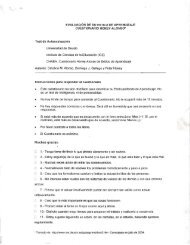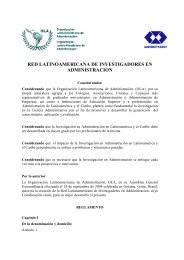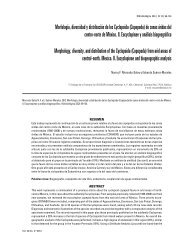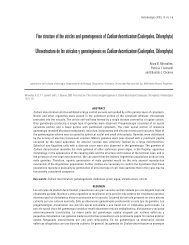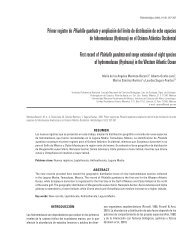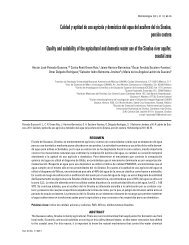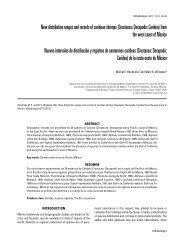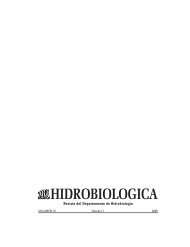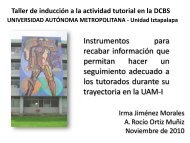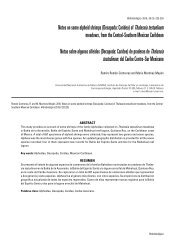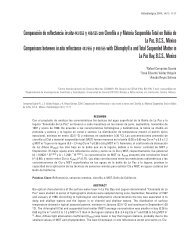LCD pixel shape and far field diffraction patterns - Páginas de ...
LCD pixel shape and far field diffraction patterns - Páginas de ...
LCD pixel shape and far field diffraction patterns - Páginas de ...
You also want an ePaper? Increase the reach of your titles
YUMPU automatically turns print PDFs into web optimized ePapers that Google loves.
266ARTICLE IN PRESSM. Fernán<strong>de</strong>z Guasti et al. / Optik 116 (2005) 265–269record the <strong>diffraction</strong> <strong>patterns</strong> are also <strong>de</strong>scribed in thissection. In Section 3, the experimental layout of one ormore <strong>pixel</strong>s produced by a <strong>LCD</strong> mask is presented. InSection 4, the experimental results are exposed <strong>and</strong> theirmain features discussed. The <strong>shape</strong> of the <strong>LCD</strong> <strong>pixel</strong> isinferred from its <strong>diffraction</strong> pattern through comparisonwith the computer-generated apertures. The <strong>LCD</strong>aperture used in a PDI, rather than the i<strong>de</strong>al circularsymmetry, has the <strong>shape</strong> of a square with blunt corners.The conclusions are drawn in Section 5.2. Photographic masksIntermediate figures between a circle <strong>and</strong> a squaremay be <strong>de</strong>scribed analytically through a single equationrestricted to the appropriate domain [6]. The aperturesproduced with this algorithm yield figures that resemblesquares with blunt corners. These silhouettes may bea<strong>de</strong>quate for mo<strong>de</strong>ling the <strong>shape</strong> of <strong>pixel</strong>s produced bydiverse digital imaging systems. This assertion will, infact, be supported by the results presented hereafter.The photographic diffracting apertures employed in thiswork were generated from the squircle equation, that is,the equation for a square/circular aperture. The polarequation for a squircle form is given bys 2 4 sin2 ð2yÞr 4 k 2 r 2 þ k 4 ¼ 0, (1)where ðr; yÞ are the polar coordinates at the apertureplane <strong>and</strong> ‘‘s’’ is the squareness parameter [6]; s ¼ 1represents a square with si<strong>de</strong>s equal to2k; while s ¼ 0represents a circle of radius k. The equation for thesquare is perhaps more clearly visualized in Cartesiancoordinates with the substitution 4x 2 y 2 ¼ r 4 sin 2 ð2yÞ:The Cartesian equation for a squircle iss 2 x2 y 2 x 2k 2 k 2 k 2 þ y2k 2þ 1 ¼ 0. (2)This expression may be factored for s ¼ 1 into ð1x 2 =k 2 Þð1 y 2 =k 2 Þ¼0; which yields a square when therestriction x 2 ; y 2 pk 2 is imposed. The parameter ‘‘s’’ is agood measure of how sharp or blunt are the corners ofthe square. This parameter may be continuously variedto smoothly change the <strong>shape</strong> of the contour from acircle toa square. The change in the aperture <strong>shape</strong> ismore sensitive when ‘‘s’’ is close to one. A typicalcomputer-generated aperture plot for s ¼ 0:9 is shown inFig. 1. The area lying outsi<strong>de</strong> the curve was ren<strong>de</strong>red inblack in or<strong>de</strong>r to produce the aperture mask. The plotsof the squircle equation for various squareness valueswere recor<strong>de</strong>d in high-contrast photographic film reducingtheir size toabout 1 mm in diameter, that is k ¼0:5mm: The upper left-h<strong>and</strong> quadrant of the diffractingapertures was photographed with an optical microscopein or<strong>de</strong>r to monitor the actual <strong>shape</strong> of the apertures.Fig. 1. Diffracting aperture plot for squareness parameter s ¼0:9:The form of the aperture in the other three quadrants issymmetrical with respect tothe quadrant shown in themicrophotographs.The apertures were illuminated directly with a HeNelaser placed 2 m apart from the aperture plane. The<strong>diffraction</strong> <strong>patterns</strong> were recor<strong>de</strong>d on high-resolutioncolor film located 3 m apart from the diffractingapertures. This distance was appropriate in or<strong>de</strong>r toconsi<strong>de</strong>r the pattern tobe in the <strong>far</strong> <strong>field</strong> <strong>and</strong> alsotofillreasonably well the 35 mm film that was used tophotograph these <strong>patterns</strong>. This simple arrangementwas favored in or<strong>de</strong>r to avoid contributions fromintermediate optical elements.3. Experimental setupThe experimental setup used toobtain the images <strong>and</strong><strong>diffraction</strong> <strong>patterns</strong> of the <strong>LCD</strong> <strong>pixel</strong>s is shown in Fig. 2.The display is a monochrome active matrix twistednematic crystal consisting of an array of 320 240<strong>pixel</strong>s with maximum contrast ratio of 80 to 1 (Kopin,CyberDisplay 320). The <strong>pixel</strong> dimensions given in thespecifications is 15 mm 15 mm <strong>and</strong> the separationbetween <strong>pixel</strong>s is 25 mm: This display was controlledwith a personal computer. The screen resolution wasadjusted so that individual <strong>pixel</strong>s could be turned on(full transparency) or off (fully darkened). The displaywas mounted on an xyz mount <strong>and</strong> placed in the vicinityof the beam waist where it is commonly positioned in aPDI scheme.Images of the open <strong>pixel</strong>s were taken using a travelingmicroscope <strong>and</strong> white light illumination. These imageswere used to confirm the position <strong>and</strong> the number ofactive <strong>pixel</strong>s. The <strong>diffraction</strong> <strong>patterns</strong> of the <strong>pixel</strong>s weretaken un<strong>de</strong>r HeNe laser illumination. The laser beamwas spatially filtered <strong>and</strong> collimated following the usuallayout of a PDI. The image was <strong>de</strong>tected with a CCD


